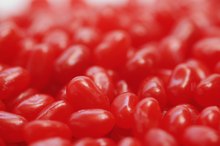A Skin Rash on the Hands and Ankles from a Food Allergy
The most common skin rash from a food allergy that can appear on the hands and ankles is hives, according to MedlinePlus 12. Hives are welts that form within a matter of minutes after someone consumes a food he is allergic to. While hives are considered harmless, if the skin breaks, there is increased risk of secondary skin infections. Hives may also be a sign of a severe allergic reaction that could be life-threatening. If you experience hives when you eat a specific food, see a doctor for evaluation.
If you are experiencing serious medical symptoms, seek emergency treatment immediately.
Food Allergy Background
Food allergies are most common in children under age 3. Only 4 percent of the adult American population suffers from a genuine food allergy, according to MayoClinic.com 12. The most common highly-allergic foods include:
- wheat
- soy
- milk
- nuts
- eggs
- fish
A food allergy occurs when someone’s immune system mistakes the proteins in food as a dangerous substance 12. The immune system attempts to ward off the proteins by creating antibodies and other chemicals that lead to allergy symptoms.
- Food allergies are most common in children under age 3.
- The most common highly-allergic foods include: * wheat
* soy
* milk
* nuts
* eggs
* fish A food allergy occurs when someone’s immune system mistakes the proteins in food as a dangerous substance 1.
Allergic Rash Symptoms
Is a Red Rash on the Cheeks a Sign of a Food Allergy?
Learn More
A rash that develops on the hands and ankles as a result from a food allergy will appear within the first hour after you eat the food, according to MayoClinic.com 12. Hives can appear and disappear in various shapes an sizes without reason. Hives are not restricted to the hands and ankles and spread to any part of the body. Hives are red or white in color and can burn or sting, according to the American Academy of Dermatology.
- A rash that develops on the hands and ankles as a result from a food allergy will appear within the first hour after you eat the food, according to MayoClinic.com 1.
- Hives are red or white in color and can burn or sting, according to the American Academy of Dermatology.
Other Symptoms
If the rash on the hands and ankles is the result of a food allergy, other common food allergy symptoms will also develop 12. These may include:
- stomach discomfort
- gas
- vomiting
- diarrhea
- nasal congestion
- itchy eyes
- asthma conditions
- tingling in the mouth
- according to MedlinePlus
Hives accompanied with dizziness, anxiety, a faint pulse, flushed skin and a drop in blood pressure is alarming. Call 911 for immediate medical attention.
Treatment
Can Food Allergies Make Your Hand Itch & Turn Red?
Learn More
A skin rash on the hands and ankles from a food allergy is treated by identifying and avoiding exposure to the food allergen, according to the American Academy of Dermatology 12. Oral and topical antihistamines are useful to reduce inflammation in the skin and alleviate the itch. In extreme cases, a doctor may prescribe corticosteroid creams to treat the allergic rash.
- A skin rash on the hands and ankles from a food allergy is treated by identifying and avoiding exposure to the food allergen, according to the American Academy of Dermatology 1.
- Oral and topical antihistamines are useful to reduce inflammation in the skin and alleviate the itch.
Consideration
MedlinePlus recommends seeing a doctor if you experience a whole-body reaction with a skin rash. If you suspect you have a food allergy, make an appointment to see an allergist 12.
Related Articles
References
- Mayo Clinic: Food Allergy
- Medline Plus: Food Allergy
- Food Allergy Research and Education (FARE). Facts and Statistics.
- Food Allergy Research and Education (FARE). Facts and Statistics.
- Zukiewicz-sobczak WA, Wróblewska P, Adamczuk P, Kopczyński P. Causes, symptoms and prevention of food allergy. Postepy Dermatol Alergol. 2013;30(2):113-6. doi:10.5114/pdia.2013.34162
- Tupper J, Visser S. Anaphylaxis: A review and update. Can Fam Physician. 2010;56(10):1009-11.
- American College of Allergy, Asthma and Immunology. Food Allergy Diagnosis. Updated February 12, 2019.
- American Academy of Allergy, Asthma & Immunology. Food Allergy: A Practice Parameter Update. 2014. doi:10.1016/j.jaci.2014.05.013
- Boyce JA, Assa’ad A, Burks AW, et al. NIAID-Sponsored Expert Panel. Guidelines for the Diagnosis and Management of Food Allergy in the United States: Report of the NIAID-Sponsored Expert Panel. The Journal of Allergy and Clinical Immunology, 2010. doi:10.1016/j.jaci.2010.10.007
- Branum AM, Lukacs SL. Food Allergy Among U.S. Children: Trends in Prevalence and Hospitalizations. NCHS Data Brief, Centers for Disease Control (CDC), 2008.
- Food Allergy Research and Education (FARE). Facts and Statistics.
- Liu AH, Jaramillo R, Sicherer SH, et al. National Prevalence and Risk Factors for Food Allergy and Relationship to Asthma: Results from the National Health and Nutrition Examination Survey. Journal of Allergy and Clinical Immunology, 2010. doi:10.1016/j.jaci.2010.07.026
- Sicherer, SH. Food Allergies: A Complete Guide for Eating When Your Life Depends on It. Baltimore, MD: The Johns Hopkins University Press (2013).
Writer Bio
Diane Marks started her writing career in 2010 and has been in health care administration for more than 30 years. She holds a registered nurse license from Citizens General Hospital School of Nursing, a Bachelor of Arts in health care education from California University of Pennsylvania and a Master of Science in health administration from the University of Pittsburgh.









